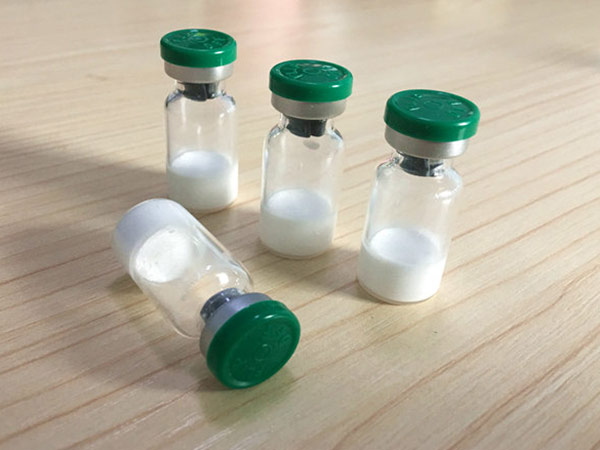- Product Name: IGF-1 LR3
- Appearance: White lyophilized powder
- Purity: 99%min
- Specification: 2mg/vial, 5mg/vial
- CAS No.: 946870-92-4
What Is IGF-1 LR3
Long arginine 3-IGF-1, abbreviated as IGF-1 LR3 or LR3-IGF-1, is a synthetic protein. It lengthened analog insulin-like growth factor 1 (IGF-1). It differs from native IGF-1 in that it possesses an arginine instead of a glutamic acid at the third position in its amino acid sequence, and also has an additional 13 amino acids at its N-terminus, for a total of 83 amino acids.
IGF-1 LR3 retains the pharmacological activity of IGF-1 as an agonist of the IGF-1 receptor, has a very low affinity for the insulin-like growth factor-binding proteins (IGFBPs), and has improved metabolic stability. As a result, it is approximately three times more potent than IGF-1 and possesses a significantly longer half-life of about 20–30 hours. It is a sterile filtered white lyophilized(freeze-dried) powder.
Essentially, when IGF-1 LR3 peptide is active in the body, it functions differently in different types of tissues. For instance, in muscle tissue, it makes the muscle more sensitive to insulin’s effects, such as a reduction in fat storage. But while IGF-1 LR3 helps fat reduction, a person using it will experience weight gain because of the increase in pure-muscle weight.
What Is IGF-1 LR3
- Promotes protein synthesis in the body.
- Regulates the storage of fat and directs its use for energy production. This leads to a significant fat loss.
- Promote positive effects of metabolism; increase lean body mass and reduce fat.
- It can enhance the regeneration properties of human nerve tissue.
- Up-regulate antioxidant effect and ligament strength.
- It promotes the proliferation of muscle cells, resulting in fuller muscle tissue.
- Optimal IGF-1 and growth hormone levels are essential for bone development during childhood and throughout adulthood.
- Improve athletic performance.
- Reduce recovery time after injury.
More About IGF-1 LR3
Cell division
Like IGF-1, IGF1-LR3 is an effective stimulator of cell division and proliferation. Its main function is to promote connective tissues, such as muscles and bones. But it also promotes cell division in liver, kidney, nerve, skin, lung and blood tissues.
IGF-1 can be regarded as a mature hormone, because it not only promotes cell proliferation, but also promotes cell differentiation. In other words, IGF-1 promotes the maturation of cells so that they can perform their specialized functions. Unlike IGF-1, IGF1-LR3 can remain in the blood for a long time. This property makes IGF1-LR3 a more effective molecule. The same dose of IGF1-LR3 provides about three times the cell activation capacity of IGF-1.
IGF1-LR3 and all GF-1 derivatives will not promote cell enlargement, but will promote cell division and proliferation. Take muscle as an example, IGF1-R3 will not cause muscle cells to become larger, but will increase the total number of muscle cells.
Fat metabolism and diabetes
IGF1-LR3 indirectly promotes fat metabolism by binding to IGF-1R receptor and insulin receptor. These effects increase the ability of muscles, nerves and liver cells to absorb glucose from the blood. This leads to an overall drop in blood sugar levels, which then triggers adipose tissue and liver to start breaking down glycogen and triglycerides. Overall, this leads to a net reduction in fat tissue and net energy expenditure.
Damage myostatin
Myostatin (also known as growth differentiation factor 8) is a muscle protein that mainly inhibits the growth and differentiation of muscle cells. Although this function is important to prevent excessive hypertrophy and ensure normal healing after injury, it is sometimes necessary to inhibit myostatin.
The ability to stop the function of myostatin may be useful in people such as Duchenne’s muscular dystrophy (DMD) or who suffer muscle loss when immobile for a long time. In these cases, inhibiting this natural enzyme can help slow down muscle weakness, maintain strength and avoid illness. GF1-LR3 and other IGF-1 derivatives can counteract the negative effects of myostatin to protect muscle cells and prevent apoptosis. IGF1-LR3 has a long half-life, is very effective in resisting myostatin, and seems to work by activating a muscle protein called MyoD.
Anti aging
IGF1-LR3 can promote tissue repair and maintenance throughout the body, so it becomes a protective molecule against cell damage and aging. Studies in cattle and pigs indicate that the administration of IGF1-LR3 may be an effective solution to counteract the effects of cellular aging. A number of ongoing studies are trying to determine whether IGF1-LR3 can be used to prevent various diseases such as dementia, muscle atrophy and kidney disease.
Glucocorticoid signaling
Glucocorticoids are mainly secreted by the adrenal glands and are important clinical drugs that can be used to control pain and reduce inflammation caused by autoimmune diseases, nerve damage, cancer and so on. Unfortunately, glucocorticoids have many undesirable side effects, such as muscle wasting, increased fat and decreased bone density. Use IGF1-LR3 to reduce the side effects of glucocorticoids, so that patients can be treated more effectively.
